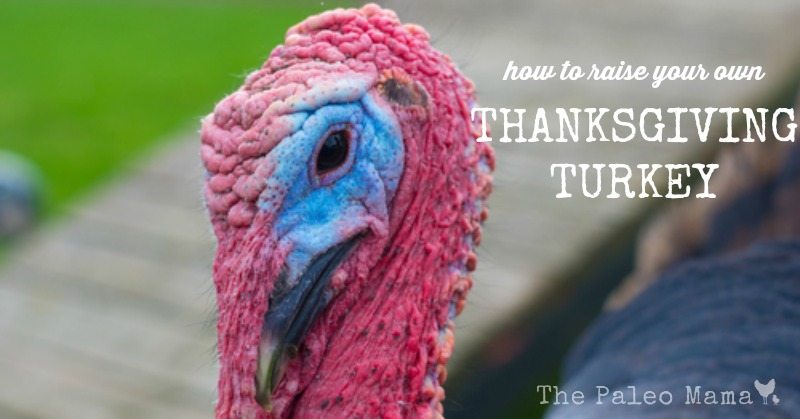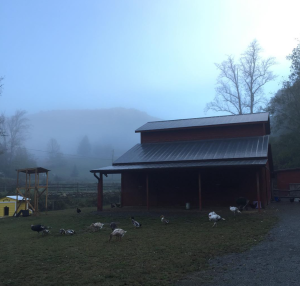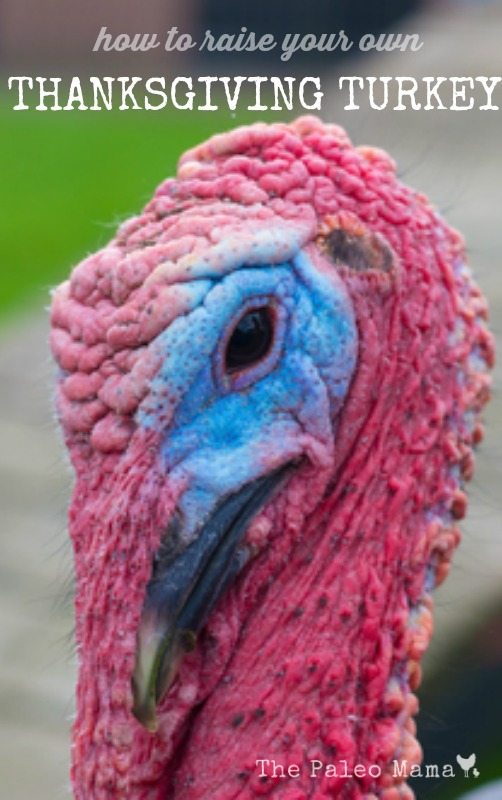
Raising the turkey you will eat on Thanksgiving Day may be something you want to consider doing. Turkeys can be a fun addition to a small farm or homestead and I’m going to share a few things I have learned on how to raise your own turkeys. But before you start, there are a few things you need to consider.
- If you are hoping to save money on your Thanksgiving bird by raising it yourself, you are likely to be disappointed. It will be hard to compete with the sale price of the commercially grown supermarket turkeys.
- You will be challenged to keep your turkey free from predators. Just about every wild critter (even some domesticated ones) is on the prowl for a big, juicy turkey meal.
- Turkeys have really cute personalities and love to be around people. It may be hard to decide if they are your family pet or your Thanksgiving Day meal.
- Turkey raising is a challenge—get rid of your romantic notions about it. There will be great days, and there will be difficult days. If you succeed, you will produce a Thanksgiving turkey meal that is way more flavorful than any storebought bird could give you. But if you blow it, you’ll be buying that last minute, dried out bird at the market, hoping no one will notice.
If you’ve been reading our Natural Homestead blogs and posts, you know that we decided that raising our own pastured turkeys—including one for our Thanksgiving dinner—was just what we wanted to do. We purchased 5 2-month old turkeys (yes, we decided to skip the infant stage this first time around) to join our menagerie and forage to their heart’s content out in our pasture. We built a turkey roost for them to use in the pasture during the day, and they will be able to roost in the closed barn at night.
In this blog I want to share some of our firsthand experiences, and more of our research into how to raise turkeys to help you make a choice about raising your own. We will consider:
- What are the differences between a standard breed and a heritage breed?
- What kind of shelter do I need to prepare for my turkeys?
- What do I need to know about feeding my turkeys?
- Are there special preparations I need to make in my pasture?
- What health issues could I face with my turkeys?
- When will my turkey be ready for eating?
1. What are the differences between a standard breed and a heritage breed?
Frank and I have made the decision to raise only Heritage Breeds of homestead animals on our Gather Heritage Farm. We want to have a part in saving endangered livestock from extinction. When we moved into our forever farm we knew that we could provide the necessary elements to be a part of this endeavor.
Heritage turkeys are raised outdoors, freely roam on pasture, and eat the varied diet nature intended them to eat. Most supermarket turkeys today are raised in crowded indoor pens, and are fed a constant diet of grains, fillers, and supplements like antibiotics—just to fatten them up to meet the demands of American shoppers.
While supermarket turkeys tend to be tasteless and dry, heritage birds are juicy and flavorful. They taste the way a turkey is supposed to taste. Heritage breeds include:
- Beltsville Small White
- Black
- Jersey Buff
- Narragansett
- Royal Palm
- Bourbon Reds
- Slate
- Standard Bronze
- White Holland
- White Midget
Heritage breeds will take longer to raise. If you raise one from early spring to fall it will weigh approximately 15-18 pounds. But the meat is denser, and more flavorful. There tends to be more leg meat and less breast meat.
2. What kind of shelter do I need to prepare for my turkeys?

If you decide to start with turkey poults (infants), you will need to provide the same basic care you would give to your baby chicks. When you bring them home, dip their beaks in water to teach them how to drink. They need to be in warm temperatures (95 degrees) for the first week, and gradually less heat as they feather out.
Heritage turkeys are more spunky than standard breeds, and can figure any way out of their pen—up, under, through, between. Make sure the fencing around your turkey pen is secure and can keep your turkeys in and their predators out! Fencing should be as high as possible, at least four feet. Use woven-wire fencing and metal T-posts or wooden posts.
If you are raising turkeys to breed or places for broody hens to sit on eggs, you will need a pen with solid sides and separate housing for toms and hens. Allow the toms and hens to forage separately.
Provide your growing turkeys with a turkey roost with a roof to keep them safe. The higher you make it, the safer they will be. Wild turkeys roost way up high in trees. A 5 by 8 foot roost will house about 20 turkeys.
We raise free-range turkeys so we don’t even have housing for them. They usually wind up sleeping on a barn stall or on their turkey roost that we built to go outside and is next to our yellow duck house. The turkey roost is over 7ft high so there is no way a predator can get them at night.
3. What do I need to know about feeding my turkeys?
Their first food should be a high protein ration with about 28 percent protein fuel their fast growth. By 8 weeks they can be switched to a 20-22 percent feed, and after they begin foraging you can use a 18-20 percent protein, and give them some cracked grains to help their digestive systems utilize their feed.
When you are fattening them up for the Thanksgiving table, toss in excess or bug-infested apples, tomatoes, and other produce as treats. You can find full information on feeding your turkeys here.
4. Are there special preparations I need to make in my pasture?
If you have a large, lush pasture, your turkeys will be able to free range, moving from area to area as they deplete the grasses and eat the bugs. If you have a smaller pasture, you may want to consider whether you can provide enough food material for the birds to thrive. For pastured or limited range turkeys, alfalfa, clover, and grasses such as orchard grass serve turkeys very well; however, fescue is not recommended. Contact local Cooperative Extension agents to ascertain the best choice of pasture browse crops and planting strategy for your locale.
Remember that turkeys are very sensitive to numerous mycotoxins (toxins produced by fungus and mold), so moldy grains and grasses should be avoided at all cost. Turkeys are excellent insect foragers. The only insects they will not eat are the ones they cannot catch.
5. What health issues could I face with my turkeys?
Turkeys are pretty hardy, but there are some potential health concerns in raising them. Some of these include:
- Blackhead (Histomoniasis)—a parasite found in earthworms from poultry droppings. Symptoms include bright yellow droppings and droopiness, diarrhea and weight loss.
- Coccidiosis—a parasitic disease more common to commercial turkeys, recognized by watery diarrhea and malaise. It must be diagnosed by a vet.
- Lice—turkeys get lice just like chickens. Make sure you treat them regularly with a lice powder that is suitable for raising organic turkeys.
With careful maintenance and diligence, you should be able to raise your turkeys disease-free and healthy.
6. When will my turkey be ready for eating?
Turkeys for meat are ready for slaughter at 24-28 weeks for standard breeds, but heritage breeds normally take longer to raise to slaughter readiness. Most will weigh 14-18 pounds by Thanksgiving time. You will need to keep that bird around another year to get it to a larger size.
Processing a turkey is more difficult than chickens because they are heavier, more energetic and more intelligent. They are also loaded with much more personality, and it may be very hard for you to consider doing anything hurtful to that family member. You can bring them to a processor to do the hard work for you or have someone else do the hard deed.
Fortunately, if you choose to raise heritage breeds, you can allow your turkey family to grow and expand so you will always have some of these beautiful birds in your pasture. That’s having your turkey and eating it too!

Sources
- https://smallfarm.about.com/od/farmanimals/tp/How-To-Raise-Turkeys.htm
- https://sagebrush-mama.hubpages.com/hub/The-Good-The-Bad-And-The-Ugly-Sides-Of-Raising-Your-Own-Turkey
- https://www.theselfsufficienthomeacre.com/2013/11/how-to-raise-turkeys.html
- https://www.sustainabletable.org/432/talking-turkey
- https://www.communitychickens.com/thinking-about-raising-turkeys/
- https://www.albc-usa.org/documents/turkeymanual/ALBCturkey-3.pdf
Leave a Reply